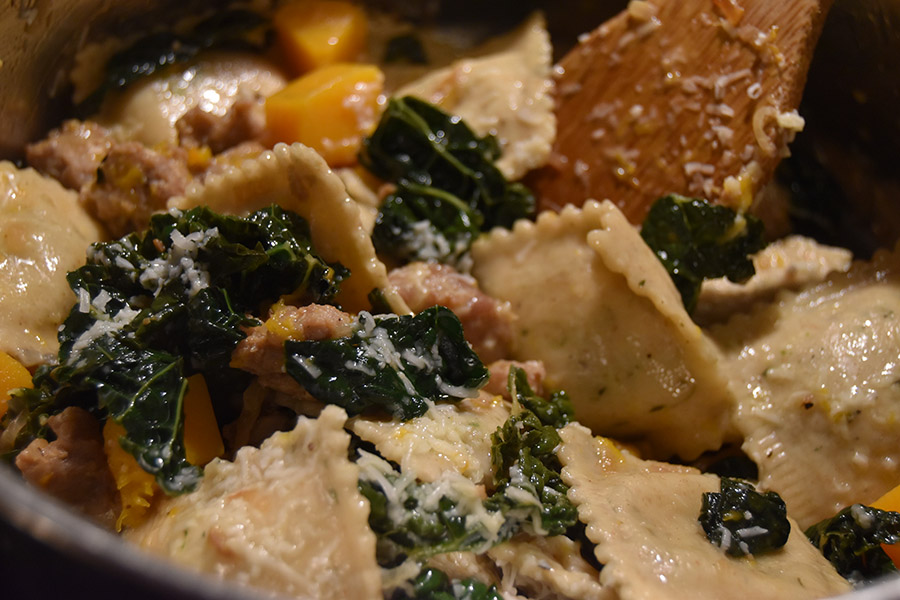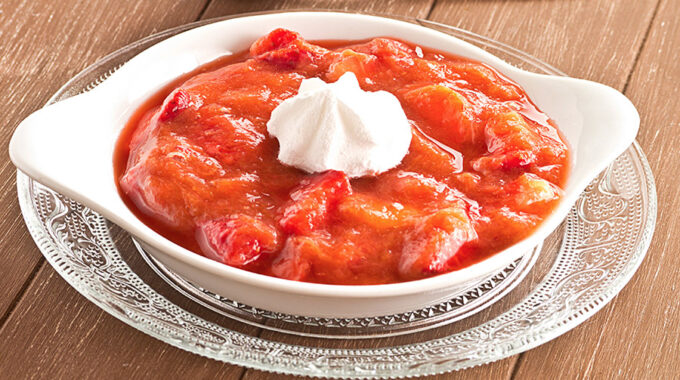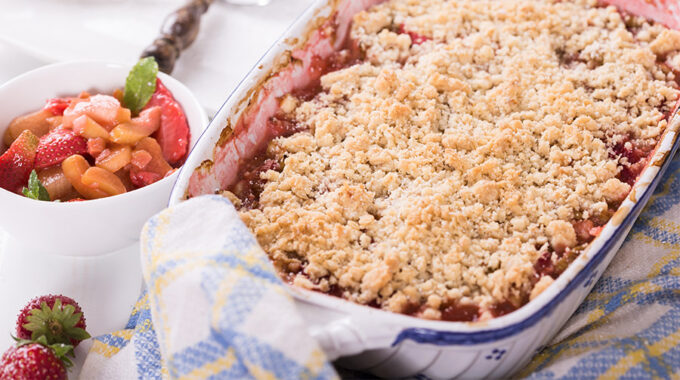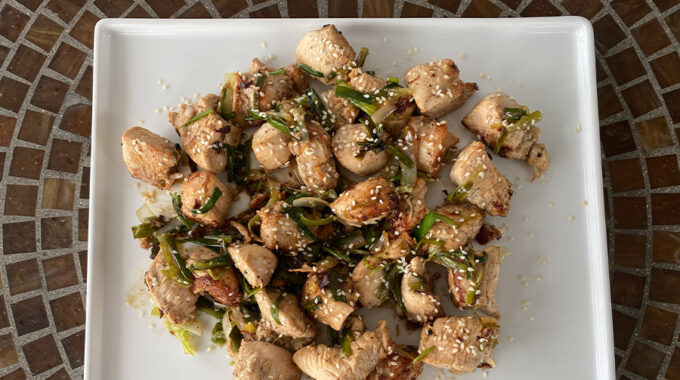Strawberry Rhubarb Compote by Norma Frye A compote or compôte (French for 'mixture') is a…
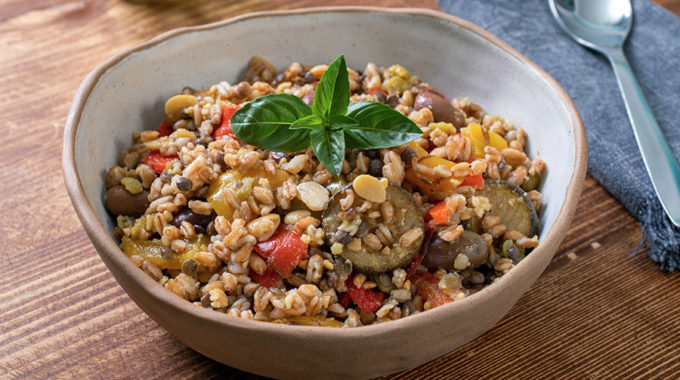
Recipe: Ellen’s Winter Farrotto
By Ellen Green
I got asked to write a recipe for the newsletter on pretty short notice this month, and I was stumped for what to write about. It’s an awkward waiting sort of time of year in the food world (unless you’re tapping maple trees–then it’s mighty busy!). Nothing is in season locally, the winter staples are getting a little old, everything is gray and icy.
And I thought to myself, I can’t think of anything to write. So what do I cook when I can’t think of anything to cook?
The answer: risotto. I grew up eating it–I have some roots in northern Italy–and when I started volunteering at Open Table, it was what I’d always whip up when we had just a few pounds of peas to work with, or a single ham someone had donated, or a few squash left over from grocery distribution. Put it in risotto. It’ll be good, and it’ll feed a lot of people.
That said, there are plenty of recipes out there for risotto. Type “risotto” into your search engine of choice, and you will find them. But I started making it with farro in college–so, farrotto–and the result is much more substantial and rib-sticking. Compared to the traditional white arborio rice, farro packs quite a bit of fiber and protein. Add a light salad or a piece of fruit, and farrotto is a meal on its own. And it’s a great recipe to have in your back pocket if you’re trying to reduce your meat consumption–a little meat goes a long way in farrotto, if you use meat at all.
Farro is a type of wheat grain–what you might grind to make a whole-wheat flour. But cooked whole in water, they make a chewy, savory stew that’s a great canvas for whatever oddments are in your kitchen. You can also cook barley this way–it doesn’t take as long, and the texture is a bit different.
So: let’s get cooking. The recipe below is one of my favorite combinations, but there are some other options listed at the bottom.
Ellen’s Winter Farrotto
Serves: 4-6 as a main dish or 8-10 as a side, with some leftovers (it reheats beautifully in the microwave)
Time: about 30 min active, 90 min total
Equipment: knife, cutting board, heavy-bottomed pot that holds about 1 gallon (or use a flame tamer for a lighter pot), a lid that fits the pot, a sturdy stirring spoon, a stove or hot plate
Ingredients
- about 1 lb/2 cups butternut or delicata squash in 1 inch cubes, measured after peeling and seeding
- 1 medium yellow onion, ¼ inch dice
- 2-4 cloves garlic, minced
- 1 bunch of kale, stems removed and cut into ribbons (should be about a big double handful when you’re done cutting it up)
- ¼ cup parsley, chopped
- 1 lb sweet Italian sausage, squeezed out of its casings
- water–you might need 2 cups total
- 2 tbsp olive oil
- 2 cups farro
- 6 cups low-sodium chicken or vegetable broth (if you make your own, use it now!)
- ½ cup grated pecorino or other hard Italian cheese, plus more to serve
- ¼ cup butter, more to taste (can use extra-virgin olive oil instead)
- salt and pepper
Directions
- Prepare the vegetables and sausage.
- Heat a heavy-bottomed pot on medium-high and brown the sausage. Get it nice and crispy. Scoop it out of the pan and set it aside. If there’s a bunch of brown stuff stuck to the pot (there probably is), pour in half a cup or so of water. Bring it to a boil and scrape vigorously until the pot is mostly clean. Pour the liquid over the sausage.
- Heat the oil in the pot on medium heat until it shimmers, then add the onion. Cook, stirring occasionally, until it’s soft and translucent, but don’t let it brown.
- Add the farro and garlic, and raise the heat to medium-high. Cook, stirring constantly, until it smells toasty and the farro is starting to brown in spots.
- Add the broth and cover. Bring to a boil, and then reduce the heat to low and simmer for 40 minutes. Stir once or twice and add water if the liquid boils off too quickly–at the end of the 40 minutes, the farro should still be floating in liquid.
- Open it up and give it a stir and a taste. The farro won’t be fully cooked, but it should be starting to soften. If it’s still pretty hard, give it another ten minutes or so before proceeding.
- Add the squash, kale, and sausage (with any liquid) to the pot and stir it in. If necessary, top up the liquid again so that everything is floating. Raise the heat to medium to get it bubbling again, then drop it back down to a simmer. Cook for about 20 minutes.
- Stir and taste again–the squash and farro should be cooked. (Farro is chewy when it’s cooked, but it shouldn’t feel dry in the middle.) If not, cover it back up and cook for another 10 minutes or so.
- When the farro is cooked, remove the lid, raise the heat to medium, and reduce the liquid until it’s more like sauce than broth–as long as it doesn’t burn, there are no wrong answers here, but do keep in mind that it’ll thicken a bit as it cools. Stir constantly so it doesn’t stick. When it’s thickened to your liking, remove it from the heat.
- Stir in the butter, cheese, and parsley, and season to taste with salt and pepper. Serve hot, and pass the cheese.
Some other combinations I really like:
- peas, basil, and fresh mozzarella, topped with fresh tomatoes
- chicken, mushrooms, and thyme
- pancetta, carrot, and sage
- ham and peas
- tomatoes, swiss chard, and green beans
If you want to avoid dairy, try swapping chopped cured olives, miso, or vegan parmesan substitute for the cheese–it does need that touch of deep umami flavor, in my opinion. I especially like using kalamata olives with tomatoes and basil.
And, because writing this up took longer than I planned, I made a squash-kale-sausage saute and put it over frozen ravioli for dinner–kinda the same thing. As we say in the Open Table kitchen, we make it work. Happy cooking!
